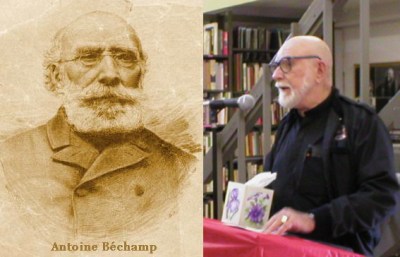 (L) Antoine Bechamp (R) Alan Cantwell
(L) Antoine Bechamp (R) Alan Cantwell
by Alan Cantwell, M.D., © 2017
Editor’s note: this was published last week at Rense.com. A century and a half ago, Antoine Béchamp (1816-1908) declared that the microzyma is the essential unit of life. As a medical doctor, microscopist, and cytologist (a specialist in the study of cells), he observed tiny, round granular bodies within the cells that glistened as tiny sparkles of refracted light.
He was not the first to see the granules, but he was the first to suspect these “little bodies” might hold the key to the origin of life. Other scientists who observed these forms named them “scintillating corpuscles” and “molecular granulations.” Béchamp explored the nature and function of these granules that are contained within all human cells.
Antoine Béchamp studied them in various diseases. In tuberculosis (TB), the unhealthy cells contained large numbers of these granules. His varied academic background in medicine, chemistry and physics, and his special expertise in the use of polarized light, allowed him to devise unique biological experiments.
Ultimately Béchamp showed that microzymas are tiny chemical factories which have the ability to ferment. The word microzyma derives from the Greek for “small” and “ferment.”
Chemical tests proved microzymas were insoluble in water; and composed of hydrogen, carbon, and other elements, and produced nucleic acid. When heated to high temperatures they lost their ability to ferment.
The microzymas were alive and teemed with chemically active energy. Béchamp declared that they were essential and indispensable anatomic cellular elements which digested, transformed, and assimilated nutrients required by the cells. He tried to kill them, but they proved indestructible.
They were present in the amoeba, the smallest form of animal life; and within the smallest forms of plant life. Microzymas of each organ behaved differently from one another with different biochemical properties. The microzymas in the organs of young people differed biochemically from those in old people.
The transformation of microzymas into bacteria
Antoine Béchamp made a tremendous scientific discovery. Under certain conditions (and by a process known as “vibrionen evolution”) he observed microzymas transform into bacteria!
First, they enlarged into round coccoid forms. Then the round forms might couple into two or more units; or they might sprout into rod forms of bacteria. Béchamp was sure the “little bodies” were involved in the fermentation process and in the production of disease.
Where do microzymas come from? He startled the scientific world by declaring:
“They are the organized and yet living remains of beings that lived in long past ages.
“They are the transmitters of heredity. Within the chromatin material of the human sperm are contained all the microzymian granules needed to genetically reproduce all the different cells essential for the reproduction of the human species.”
Béchamp taught that all life arises from microzymas. After many laboratory experiments and microscopic examinations of these granules, the physician-scientist claimed that microzymas were capable of developing into common living organisms that go by the name of bacteria.
Some of these intermediate bacterial stages were regarded by experts as different species, but to Béchamp they were all related and derived from microzymas.
Bechamp versus Pasteur
Antoine Bechamp, before his death in 1908, had an incredible list of scientist appointments at French universities: Examples are: Doctor of Science, Doctor of Medicine, Professor of Medical Chemistry and Pharmacy at Montpelier, Professor of Physics and Toxicology at Strasbourg.
During his lifetime Béchamp was overshadowed by chemist Louis Pasteur (1822-1895), the most celebrated scientist of the nineteenth century. Pasteur is considered the Father of Medical Microbiology. And some call him the Father of Modern Medicine, a title quite remarkable as Pasteur was not a physician.
Both men were highly-regarded members of the French Academy of Science, and each submitted their scientific findings to the Academy for review and publication.
Because Béchamp frequently criticized Pasteur’s work, an intense rivalry and feud between the two intensified in the Academy. But no matter how carefully Béchamp argued against some of Pasteur’s scientific methods and conclusions, the Academy always gave the nod to Pasteur.
As a chemist, Pasteur lacked Béchamp’s varied professional accreditations in the fields of biology, physics and pharmacology. Despite this, Pasteur achieved great fame by saving the French beer and wine and silkworm industries, and with pasteurization and vaccine research.
Louis Pasteur was consumed with fermentation experiments and with proving that “air germs” were the basis for human disease — although he provided no explanation for the origin of atmospheric germs. He had nothing to contribute as to how life began on Earth.
In Béchamp’s view, Pasteur’s “air germs” had nothing to do with the origin and appearance of these microzymas in tissue. In fact, he wrote that Pasteur’s air germs most likely derived from dying life-forms.
Adding more heresy to Pasteur’s dogma, Béchamp wrote that without oxygen, microzymas do not die—they go into a state of rest!
While Pasteur lacked Béchamp’s understanding of disease pathology, he established through his discoveries the essential political connections that extended as high up as the Emperor of France.
The times favored Pasteur because his ideas were in tune with the science and the politics of his day; and Béchamp’s ideas were not.
Béchamp, despite his brilliance, was eventually eclipsed by the younger Pasteur. His research can be explored in the English edition of his book, The Blood and its Third Anatomic Element, published posthumously in 1912.
The details of the scientific feud can be found in Ethel Douglas Hume’s book, Béchamp or Pasteur?: A Lost Chapter in the History of Biology (1923). She believes that Pasteur plagiarized Béchamp. Remarkably, both books are still in print and available from Internet book sources.
Microzymas and bacterial pleomorphism
Robert Koch was a legendary figure in microbiology for his discovery in the late nineteenth century of acid-fast bacteria as the cause of tuberculosis (TB). He was rigid in his belief that a specific germ had only one form (monomorphism).
Thus Koch opposed all research showing some germs had more than one form, which is known as pleomorphism.
Thus, from the very beginning of bacteriology there was conflict between the monomorphists and the pleomorphists, with the former totally overruling the latter and dominating microbiology to this day.
GumshoeNews will publish Part 2 soon. Alan Cantwell is a retired dermatologist, author of several books on AIDS and on cancer. He lives in Los Angeles.






























You can read all of Bechamp’s book here:
http://www.whale.to/v/bechamp_b1.html
Here is an example of Bechamp’s insights. Take some blood from your arm and spill it on the table. After a while it will coagulate. Why? Orthodox medicine says it is merely a chemical reaction, based on the exposure of the blood to oxygen in the air.
Bechamp says it is the organizing capacity of the microzymas that causes the coagulation.
Love this!
Is there anywhere else, like “Bitchute” to see this clip?
This clip has been BLOCKED/REMOVED … where “ELSE” can it be viewed
It was blocked on youtube but (fyi) there are many other video platforms that people post videos because to, simply because they might use several ones… is it so hard to grasp?
your video is unavailable.
Thank you so much !
Beer, Anyone?
I take this from “Louis Pasteur: Free Lance of Science,” by Rene Dubos (available online at archive.org):
“In 1897, Buchner extracted from yeast a soluble fraction, which he called “zymase” and which was capable of producing alcohol from sugar in the absence of formed, living yeast cells. … Hans and Eduard Buchner were attempting to break up yeast by grinding it with sand in order to obtain a preparation to be used for therapeutic purposes.
“The yeast juice thus obtained was to be employed for animal experiments but underwent alteration rapidly. As the ordinary antiseptics were found unsuitable to prevent the growth of bacteria, Buchner added sugar in high concentration to the juice as a preservative.
“To his great surprise, an evolution of carbon dioxide accompanied by production of some alcohol took place immediately and it was the marked action of the juice upon the added sugar which revealed to him that fermentation was proceeding in the absence of living yeast cells.”
(Fermentation and coagulation are among Bechamp’s proofs of life. I am quite sure that the Powers That Be dropped both Robert Koch and Louis Pasteur into our midst to prevent the important discoveries of Bechamp from being used. See my arguments to this effect in “Consider the Lilies,” 2013, free download at maryWmaxwell.com)
In this news story today,
http://www.abc.net.au/news/2017-03-24/chemotherapy-doctor-settles-unfair-dismissal-with-st-vincents/8382666
a Sydney oncologist wins (by settlement) his claim that he should not have been dismissed from practicing at St Vincent’s hospital for giving lesser doses of chemo than recommended.
“Dr Grygiel told a parliamentary probe last year that he decided on a level of dosage for the chemotherapy drug in question 12 years before guidelines were introduced in 2006.
“He said he had not changed his practices because there was no evidence there was a more effective treatment.
“The dosing controversy led to persistent calls for then NSW health minister Jillian Skinner to step down.” (which way?)
This is fascinating! Do you suppose this has anything to do with the idea that extinct species can be brought back in a laboratory?
Are there any living doctors who believe in Béchamp’s View points on terrain theory?
WHERE IS PART 2?
[…] involved. Now would you be more likely to deduct that those viruses come from within our bodies as microzymas (as Antoine Béchamp said) or from outside in the air – as Louis Pasteur would have us […]
[…] characteristic microbe of a disease might be a symptom instead of a cause.” In his book Mycrozymas, Béchamp laid the foundation for the concept of pleomorphism. Why bring up Bechamp now? Because […]
As a retired Australian Naturopath and Medical Herbalist, with a Science Masters degree and having lectured the Health Sciences for the last eight years of my working life, please allow me to express a fact of interest towards the conversation. Flies show up “after” the garbage has been deposited….. To clean up.